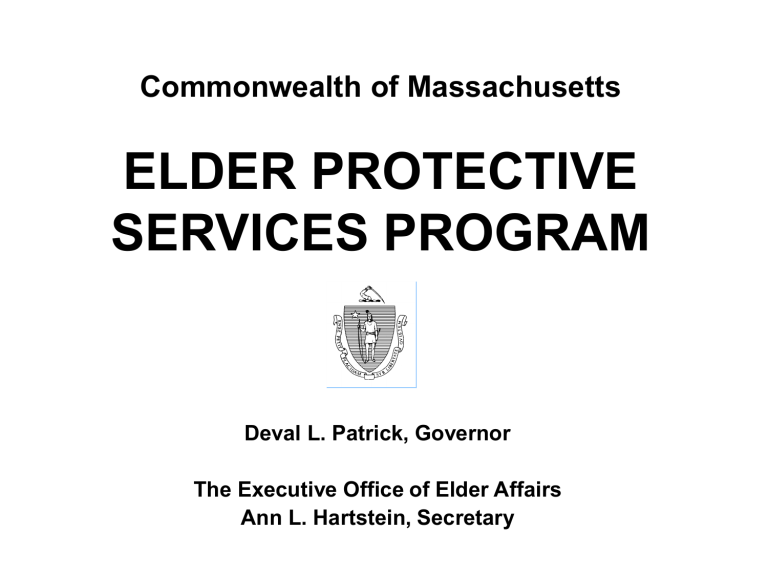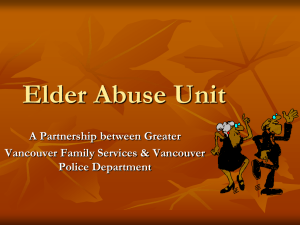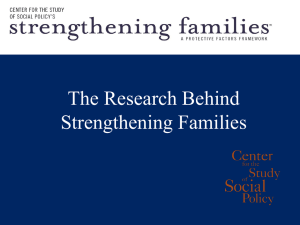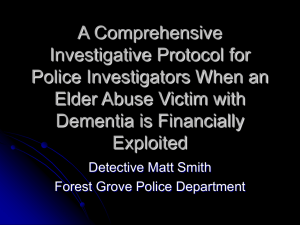Commonwealth of Massachusetts ELDER PROTECTIVE

Commonwealth of Massachusetts
ELDER PROTECTIVE
SERVICES PROGRAM
Deval L. Patrick, Governor
The Executive Office of Elder Affairs
Ann L. Hartstein, Secretary
Presenter:
Deborah Fogarty
Director, Protective Services
Executive Office of Elder Affairs, 5 th Floor
One Ashburton Place
Boston, MA 02108
(617) 222-7495 deborah.fogarty@state.ma.us
COMPONENTS OF ELDER
PROTECTIVE SERVICES PROGRAM
• Elder Protective Services
– 22 Designated Agencies
– Intake, Investigation, Intervention
• Elder Abuse Hotline ( 1-800-922-2275 )
– During business hours calls are routed to the appropriate PS
Agency, calls are answered and reports taken by Hotline workers after business hours, weekends and holidays
• Guardianship Program
– Five contract agencies
– 170 guardianship slots for PS clients
• Money Management Program
– 25 designated programs
– 1482 elders assisted per month
WHAT IS ELDER ABUSE?
• The infliction of physical, emotional, or psychological harm on an older adult
• Elder abuse can also take the form of financial exploitation or intentional or unintentional neglect of an older adult by the caretaker
THE LAW
• Protective Services governed by M.G.L. c. 19A §
14-26
• Regulations 651 CMR 5.00
• Reporting: Mandated versus Non-Mandated
• Report to local PS agency covering town where elder resides ( www.800ageinfo.com
) or after normal business hours Elder Abuse Hotline
1-800-922-2275
GOAL OF PROTECTIVE
SERVICES PROGRAM
‘The goal of the Protective Services Program is to prevent, remedy or eliminate the effects of abuse on the elder. While the primary focus is on ending or alleviating abuse, other critical program goals include: freedom, safety, least disruption of lifestyle and the least restrictive care component.’
PROGRAM PHILOSOPHIES
• Right to Self-determination
– Based on elder’s capacity to consent
– Applies to investigation and service provision
– Impact on risk
• Least restrictive, appropriate intervention
CAPACITY TO CONSENT
‘The Elder's ability to understand and appreciate the nature and consequences of decisions about Protective Services, including the benefits and risks of and alternatives to any proposed services, and to reach an informed decision.’
TYPES OF ABUSE
TYPES OF ABUSE
• Physical abuse: the non-accidental infliction of serious physical harm or the threat to do so where it is believed the person has the capacity to carry out the threat.
• Emotional abuse: the non-accidental infliction of serious emotional injury. There must be a relationship between the action and reaction.
TYPES OF ABUSE
(continued)
Question 1: Sexual Abuse of elders includes:
A. Rape
B.
‘Forcing’ an elder to watch pornography
C. Sexually inappropriate language by a grandson to his grandmother
D. Inappropriate or harmful personal care of an elder by his daughter
E. All of the above
TYPES OF ABUSE
(continued)
Question 1: ANSWER
E. All of the above
Sexual abuse: sexual assault, rape, sexual misuse or sexual exploitation or threats of abuse. Includes harmful genital practices.
TYPES OF ABUSE
(continued)
• Sexual abuse: sexual assault, rape, sexual misuse or sexual exploitation or threats of abuse.
• Financial exploitation: a non-accidental act or omission by another person, without the consent of the elder, which results in a substantial monetary or property loss to the elder or gain to another individual. May also include gaining control over an elder’s assets.
TYPES OF ABUSE
(continued)
• Caregiver neglect:
failure or refusal by a caretaker to provide one or more basic necessities essential for physical well-being, which has caused, or will immediately result in, serious physical harm
.
• Self-neglect:
failure or refusal by an elder to meet one or more basic necessities essential for physical well-being, which has caused, or will immediately result in, physical harm.
STATISTICS
(comparison of FY 2005 through FY 2011)
20,000
18,000
16,000
14,000
12,000
10,000
8,000
6,000
4,000
2,000
0
FY
2005
FY
2006
FY
2007
FY
2008
FY
2009
FY
2010
FY
2011
Reports
Investigations
Completed
Abuse Confirmed
Number of confirmed cases
( for FY 2010 and 2011)
3000
2500
2000
1500
1000
500
0
FY2010 FY2011
Physical
Emotional
Sexual
Financial
Neglect
Self-neglect
SIGNS AND SYMPTOMS
SIGNS AND SYMPTOMS
Question 2: Which of the following may be indicators of Physical Abuse?
A. Unexplained scars or bruising at different stages of healing
B. Imprint injuries
C. Bilateral injuries
D. Injuries not consistent with explanation
E. All of the above
SIGNS AND SYMPTOMS
(continued)
Question 2: ANSWER
E. All of the above- all are potential indicators of Physical Abuse
SIGNS AND SYMPTOMS
• Physical Abuse
► Bruises, welts, cuts, scratches
►Ligature marks
►Human bite marks
►Bilateral and imprint injuries
►Burns that appear to be from an object (e.g. cigarette)
►Spotty balding from pulling of hair
►Unexplained scars or bruising at different stages
►Injuries not consistent with explanation
SIGNS AND SYMPTOMS
• Emotional Abuse
► Emotional trauma
►Mental health or self-esteem declines
►Fear or anxiety when around others
• Sexual Abuse
►Genital, rectal, mouth or breast trauma
►Sexually transmitted disease
►Trauma, such as PTSD or upset when bathed
SIGNS AND SYMPTOMS
(continued)
Question 3: True or False: An 84 year old brittle diabetic not consistently taking (or being given) her medications should be reported for Caregiver Neglect or Self
Neglect.
SIGNS AND SYMPTOMS
(continued)
Question 3: Answer
True- although no harm may have occurred, due to medical conditions she is at ‘immediate risk of harm.’
SIGNS AND SYMPTOMS
• Caregiver neglect and self-neglect
► Malnourished or dehydrated
►Personal care poor
►Inappropriate clothing
►Untreated injuries or medical conditions
►Mismanagement of medications
►Infestation of insects, rodents or other pests
►Extreme clutter
►Inappropriate facilities
SIGNS AND SYMPTOMS
• Caregiver neglect and self-neglect
(continued)
► Unsafe environment
►Lack of utilities
►Lack of appropriate services
►Financial mismanagement
►Lack of appropriate supervision
►Unsafe or dangerous behavior
SELF-NEGLECT
• Prevents elder from remaining safely in the community.
• Competent elder refusing assistance or no caregiver present.
• Underlying causes include: resistance; wanting to remain independent; increase in physical impairments; decline in cognitive functioning; substance abuse; cultural/linguistic issues; availability of services; financial issues; willingness of others to assist.
REPORTING
REPORTING
Mandated Reporters (M.G.L. 19A (15)(a))
Any physician, physician assistant, medical intern, dentist, nurse, family counselor, probation officer, social worker, police officer, firefighter, emergency medical technician, licensed psychologist, coroner, registered physical therapist, registered occupational therapist, osteopath, podiatrist, executive director of a licensed home health or homemaker agency, executive director of an assisted living or a home care corporation and executive director and outreach worker for a Council on Aging.
REPORTING
(continued)
Mandated Reporters:
• Subject to $1000 fine for not reporting
• Not liable in any civil or criminal action for filing, provided did not perpetrate, inflict or cause abuse (M.G.L. 19A (15)(d))
• Cannot be discharged, demoted or be the subject of other disciplinary action due to filing of report
• Confidentiality of reporter maintainedidentity only released to District Attorney, if applicable
REPORTING
(continued)
Non-Mandated Reporters (M.G.L. 19A
(15)(c))
Any other person may make such a report to the department or its designated agency, if any such person has reasonable cause to believe that an elderly person is suffering from or has died as a result of abuse.
REPORTING
(continued)
Question 4: True or False: Reporters need to have specific, factual information in order to file a report.
REPORTING
(continued)
Question 4: Answer: False- Specific, factual information is not needed- only a
‘reasonable cause to believe.’
REPORTING
• When to report
– Whenever you have a concern or suspicion of a problem
– You do not need to prove abuse exists before reporting.
– If you are not sure whether to report, call to consult.
• What to report
– Be as detailed as possible, including involved parties, injuries and examples
– Describe risk as much as possible.
REPORTING
(continued)
• Confidentiality of reporter
• No criminal or civil liability if report filed in good faith (M.G.L. Chapter 19A, Section
15(d))
Profile of PS Clients
• Jurisdiction of Elder Protective Services
– Elder defined as 60 years and older
– Generally resides in Community
– Alleged Victim and Alleged Perpetrator often have an On-going personal relationship
– On-going personal relationship defined as ‘at least intermittent contact of a non-business nature.’
PARAMETERS OF PS PROGRAM
• Where to call if outside jurisdiction of PS?
– Department of Public Health
– Disabled Persons Protection Commission
– Department of Mental Health
– Department of Developmental Services
– Local Police Department
• Not sure of jurisdiction- contact PS to consult
INVESTIGATION PROCESS
• After a report in screened in for investigation, a worker must:
– Initiate an emergency screening within 5 hours
– Initiate a rapid screening within 24 hours
– Initiate a routine screening within 5 days
• Investigation must be completed within 30 days, unless extension granted
• Certain reportable conditions, if substantiated, must be reported to the District Attorney, for example death, serious physical abuse or neglect, financial exploitation, and sexual abuse
• Mandated reporters must be notified of outcome within 45 days of filing report
INVESTIGATION PROCESS
(continued)
• Investigation consists of
– Contact with key information sources, including elder, family members, friends, professionals and service providers
– Medical, financial and other documentation may be requested
– Evaluation of information, reliability, and inconsistencies
– Assessment of risk and capacity to consent
• Contacts can only be made with elder’s informed consent, unless elder lacks capacity to provide
• If refusal is due to duress, PS must continue with investigation, unless this would place elder at greater risk.
PROTECTIVE SERVICES
INTERVENTION
• If allegations are confirmed, interventions may include:
– Casework intervention
– Counseling
– Coordination of services
– Advocacy
– Court intervention
– Mental health services
– Medical services and therapies
PROTECTIVE SERVICES
INTERVENTION (continued)
– Home care services
– Nutrition
– Emergency services
– Respite care
– Legal services
– Money management
– Alternative housing arrangements
– Institutional placement









